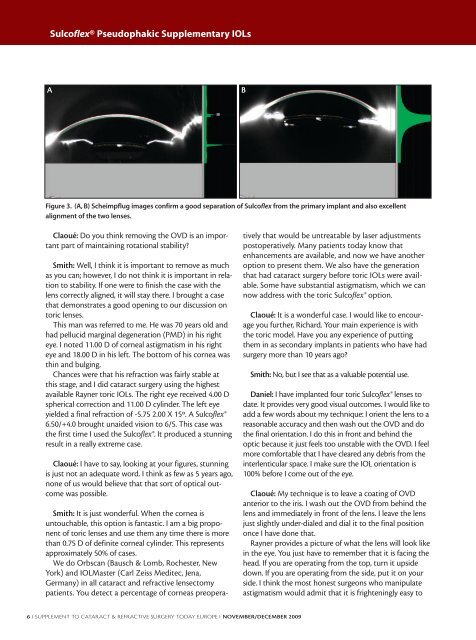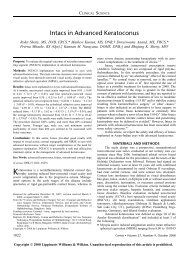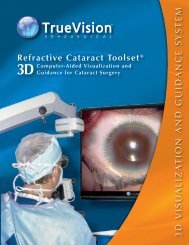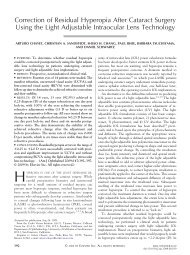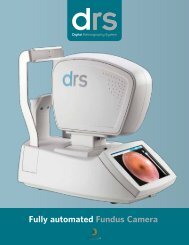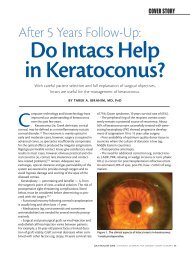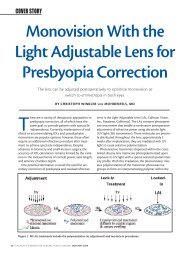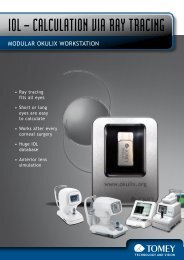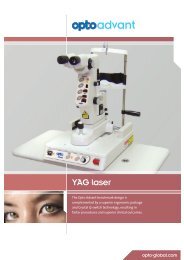Sulcoflex ®Pseudophakic Supplementary IOLs - Iogen
Sulcoflex ®Pseudophakic Supplementary IOLs - Iogen
Sulcoflex ®Pseudophakic Supplementary IOLs - Iogen
You also want an ePaper? Increase the reach of your titles
YUMPU automatically turns print PDFs into web optimized ePapers that Google loves.
<strong>Sulcoflex</strong>® Pseudophakic <strong>Supplementary</strong> <strong>IOLs</strong><br />
A B<br />
Figure 3. (A, B) Scheimpflug images confirm a good separation of <strong>Sulcoflex</strong> from the primary implant and also excellent<br />
alignment of the two lenses.<br />
Claoué: Do you think removing the OVD is an important<br />
part of maintaining rotational stability?<br />
Smith: Well, I think it is important to remove as much<br />
as you can; however, I do not think it is important in relation<br />
to stability. If one were to finish the case with the<br />
lens correctly aligned, it will stay there. I brought a case<br />
that demonstrates a good opening to our discussion on<br />
toric lenses.<br />
This man was referred to me. He was 70 years old and<br />
had pellucid marginal degeneration (PMD) in his right<br />
eye. I noted 11.00 D of corneal astigmatism in his right<br />
eye and 18.00 D in his left. The bottom of his cornea was<br />
thin and bulging.<br />
Chances were that his refraction was fairly stable at<br />
this stage, and I did cataract surgery using the highest<br />
available Rayner toric <strong>IOLs</strong>. The right eye received 4.00 D<br />
spherical correction and 11.00 D cylinder. The left eye<br />
yielded a final refraction of -5.75 2.00 X 15º. A <strong>Sulcoflex</strong>®<br />
6.50/+4.0 brought unaided vision to 6/5. This case was<br />
the first time I used the <strong>Sulcoflex</strong>®. It produced a stunning<br />
result in a really extreme case.<br />
Claoué: I have to say, looking at your figures, stunning<br />
is just not an adequate word. I think as few as 5 years ago,<br />
none of us would believe that that sort of optical outcome<br />
was possible.<br />
Smith: It is just wonderful. When the cornea is<br />
untouchable, this option is fantastic. I am a big proponent<br />
of toric lenses and use them any time there is more<br />
than 0.75 D of definite corneal cylinder. This represents<br />
approximately 50% of cases.<br />
We do Orbscan (Bausch & Lomb, Rochester, New<br />
York) and IOLMaster (Carl Zeiss Meditec, Jena,<br />
Germany) in all cataract and refractive lensectomy<br />
patients. You detect a percentage of corneas preopera-<br />
6 I SUPPLEMENT TO CATARACT & REFRACTIVE SURGERY TODAY EUROPE I NOVEMBER/DECEMBER 2009<br />
tively that would be untreatable by laser adjustments<br />
postoperatively. Many patients today know that<br />
enhancements are available, and now we have another<br />
option to present them. We also have the generation<br />
that had cataract surgery before toric <strong>IOLs</strong> were available.<br />
Some have substantial astigmatism, which we can<br />
now address with the toric <strong>Sulcoflex</strong>® option.<br />
Claoué: It is a wonderful case. I would like to encourage<br />
you further, Richard. Your main experience is with<br />
the toric model. Have you any experience of putting<br />
them in as secondary implants in patients who have had<br />
surgery more than 10 years ago?<br />
Smith: No, but I see that as a valuable potential use.<br />
Daniel: I have implanted four toric <strong>Sulcoflex</strong>® lenses to<br />
date. It provides very good visual outcomes. I would like to<br />
add a few words about my technique: I orient the lens to a<br />
reasonable accuracy and then wash out the OVD and do<br />
the final orientation. I do this in front and behind the<br />
optic because it just feels too unstable with the OVD. I feel<br />
more comfortable that I have cleared any debris from the<br />
interlenticular space. I make sure the IOL orientation is<br />
100% before I come out of the eye.<br />
Claoué: My technique is to leave a coating of OVD<br />
anterior to the iris. I wash out the OVD from behind the<br />
lens and immediately in front of the lens. I leave the lens<br />
just slightly under-dialed and dial it to the final position<br />
once I have done that.<br />
Rayner provides a picture of what the lens will look like<br />
in the eye. You just have to remember that it is facing the<br />
head. If you are operating from the top, turn it upside<br />
down. If you are operating from the side, put it on your<br />
side. I think the most honest surgeons who manipulate<br />
astigmatism would admit that it is frighteningly easy to


